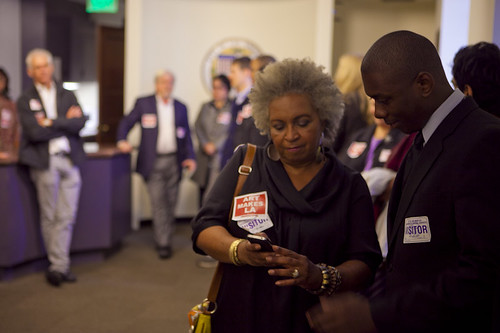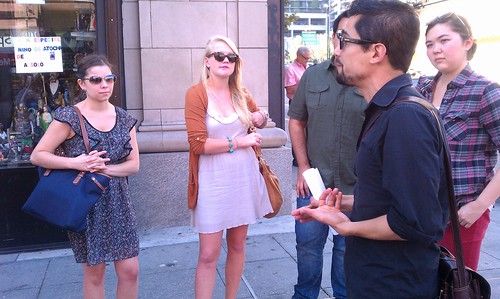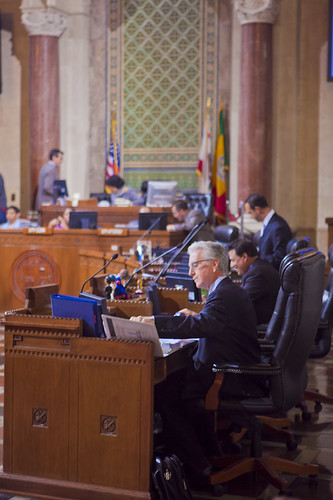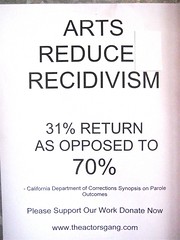WHAT CAN I DO TODAY AS AN ARTS ADVOCATE?
STRATEGIES FOR PROACTIVE ADVOCACY
By Camille Schenkkan

In reactive advocacy, an issue arises, organizations like Arts for LA go into high gear, the community mobilizes, and a decision is made that either resolves or aggravates the concern. In this model, we’re essentially waiting for the axe to fall so we can take action.
However, proactive advocacy is more difficult. It’s about creating relationships with decision-makers (city council members, school boards, etc.), and increasing public value for arts & arts education before the crisis. The strategy behind proactive advocacy is to share the incredible power of arts and culture— its economic, educational, therapeutic, community-building power— with not only elected and appointed officials, but also the millions of people who don’t already consider themselves to be arts advocates.
This is not as simple as clicking “send” on an Action Alert. It is, however, something individuals and organizations can do at any time, and will have a more lasting impact than reactive advocacy.
A list of suggestions is provided below, in no particular order:
INTRODUCE YOURSELF/YOUR ORGANIZATION TO THE PEOPLE WHO REPRESENT YOU
If you’re not sure who represents you and/or your organization in city council, school board, state assembly, etc., visit LAVote.net and enter your address.
To public officials and their staff, artists and arts organizations have invaluable resources. If that makes you laugh, think about it. We have deep roots in our communities. We often have flexible meeting or presentation space. We have networks of civically involved people who follow us via email, social media and at our events. These resources are incredibly important to those who represent our constituencies. For example, many officials now have regular newsletters with community events, and they’re constantly looking for new content. They hold many meetings, and might be happy to learn that you have a large room that they could use. Officials (and deputies!) are always looking for opportunities to connect with constituents in a positive setting, so inviting them to present an award, welcome a group of donors, or participate in a celebration of your organization’s work.
Call your elected official’s office and ask to speak to the Arts Deputy or whoever handles community relations. Sometimes this person’s direct contact information is listed on the official’s website. Once you get him or her on the phone, briefly describe your work in the community and mention resources and opportunities. Even if they’re not able to participate in a specific event, you’re introducing yourself as a valuable community partner and cultivating a relationship with the staff member most likely to bring issues involving arts & culture to the official’s attention. Maintain the relationship with this deputy via email and phone calls, and keep the opportunities coming!
When the moment comes for reactive advocacy, you can go to them as a partner (and an equal) to make your case. It puts you, your organization and your cause at an infinitely greater advantage. If someone I don’t know called me to ask a favor, I would probably decline. If someone you’ve worked with called with the same story, you’re much more likely to say yes. Position yourself as an ally and a resource, and your voice becomes stronger.
LEARN YOUR ELEVATOR SPEECH AND USE IT OUTSIDE OF THE CHOIR

We now have qualitative and quantitative data demonstrating the power of arts and arts education and its relationship to 21st century skill sets, the local economy and quality of life. That’s great—if we can share that data with people who aren’t already convinced.
Check out some of the sites and PDFs below and focus on what you find really fascinating. Learn a few facts and think about where you might be able to share them:
- The Otis Report on the Creative Economy. This annual report measures the economic impact of the creative sector in Los Angeles and Orange County. My favorite fact: the creative sector comprises about 1 million direct & indirect jobs in the region– about one in six.
- California Alliance for Arts Education‘s Research & Resources page. Their downloadable Fact Sheets can be printed and passed out at events, or linked to online. Did you know that 93% of Americans consider the arts to be a vital part of a well-rounded education?
- LA County Arts for All‘s Tools & Resources page and Publications section. Arts for All strives to restore all arts disciplines as a core curriculum for Los Angeles County’s 1.6 million public school students and has made tremendous progress. I love the information in the Arts for All School Arts Survey (2011). There’s a lot of good news but a few unpleasant surprises, such as the fact that 43% of elementary schools surveyed have no budget for arts education outside of externally raised supplemental funding.
- Our Advocacy Best Practices one-sheet provides basic information about advocacy vs. lobbying, making the case, and how to connect with policymakers.
- The California Arts Council’s Research and Reports page has links to many publications, including the Creative Vitality Index.
- Americans for the Arts has a huge Research section if you’re looking for a specific topic.
You can also look at your own organization’s impact on the community and keep that information handy. John Gallogly of Theatre West gave great public testimony in front of City Council that outlined the economic impact of one performance in his theatre. He’d asked restaurants and other vendors around Theatre West about how much of a bump in business they saw on show nights, and used that information to connect arts organizations with economic impact on local businesses. If you work for a nonprofit, you may have already put some information about your community impact into your California Cultural Data Project profile, including the number of people served, number of free performances, etc. This all becomes great fodder for a conversation about not only your organization’s community impact but the contributions of artists and arts organizations Countywide.
GREAT PLACES TO GET THE WORD OUT:
- Dinner parties & happy hours. When people hear I work with a local theatre, they often say something like “I didn’t think there was any theatre in L.A.” So I get to say, “Actually, there’s an amazing theatre community with lots of interesting new work. There are more small theatres here than in New York. Tickets can be really affordable, too—you can get $10 ones at LAStageTix.com.”
- Outside of Los Angeles. We all need to become publicists for the vibrant, diverse cultural life of LA. On a plane? Visiting relatives? “It’s a great city for arts and culture. There are actually more than three thousand arts and cultural organizations in the county.”
- Parent groups. Getting other parents invested in arts education may be just a matter of sharing the facts about its benefits. Arts for LA is also happy to work with you if you’d like to present to your PTA or School Site Council on the value of arts education. Contact us at info@artsforla.org or 213.225.7580.
- Social media provides an excellent (and free) opportunity to share information with your diverse personal network. I love watching an infographic or new report zoom around Facebook.
- Your lobby, gallery, performance space or website. I took the picture at right at the Actors Gang. This is especially clever, as it not only serves an advocacy purpose but also reminded me of their great work with incarcerated persons. Arts for LA is happy to send you PDFs or hard copies of any of our one-sheets linked above.
PUT LOCAL ELECTIONS IN YOUR CALENDAR AND READ UP ON THE CANDIDATES
Voter turnout can be as low as 12% in local Los Angeles County elections, although local elected officials have a tremendous impact on policy, quality of life and allocation of public resources. Arts for LA surveys candidates on their views on arts & culture before fall and spring elections to help you learn more before heading to the polls. Whether or not we’ve done a survey, you can find out about candidates’ views on the issues you care about by attending a forum or doing quick Google research. SmartVoter.org from the League of Women Voters has comprehensive, current information on local elections and candidates, and often links to candidate information provided by other sources as well.
SIGN UP FOR ACTION ALERTS
This isn’t strictly proactive advocacy, but it will make sure you hear about new issues as soon as possible. Advocacy campaigns work best when they go viral, so Arts for LA and other arts advocacy organizations count on organizations and individuals to spread the word quickly and widely when the moment arises. Good places to start:
- Arts for LA (Los Angeles County-focused)
- California Alliance for Arts Education
- California Arts Advocates
- Americans for the Arts
CONTACT ARTS FOR LA
Seriously. We try to move quickly, but sometimes there are advocacy alerts we haven’t posted, issues we know are coming up within a specific community, or an elected official who might need a reminder that her constituents care deeply about arts and culture. We try to keep track of ‘active advocates’ in council & school districts countywide and contact them first when we’re looking for something specific, such as a small delegation to visit their city councilmember. Call or email Arts for LA to introduce yourself and we’ll make sure you’re receiving the information relevant to your interests and community.
You know more about what’s happening in your community, so if there’s something we should be aware of and you don’t see it on our site… let us know.
INVEST IN ARTS ADVOCACY
If the list above doesn’t seem feasible or you want to do more, consider a contribution to organizations engaged in affecting cultural policy and/or supporting arts and arts education in California:
- Buy the Arts License Plate. This is the primary revenue source for the California Arts Council, which funds arts and arts education in communities statewide.
- Join Arts for LA as a member (or donate). Memberships start at $25 for individuals and $100 for organizations. Donations start at $10.
- Join California Arts Advocates, California Alliance for Arts Education, or Americans for the Arts.






